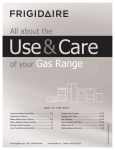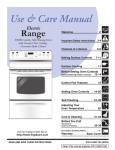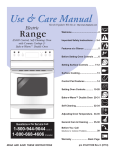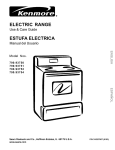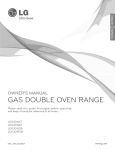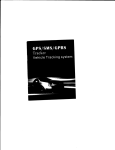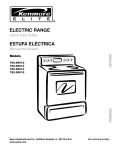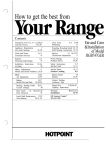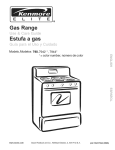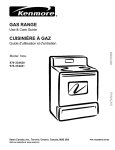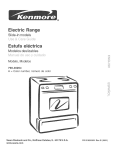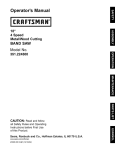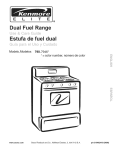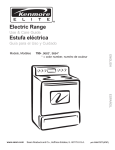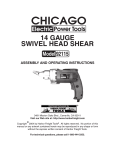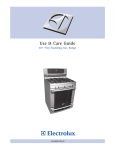Download Kenmore 790.99014 User's Manual
Transcript
ELECTRIC
RANGE
ESTUFA ELECTRICA
.
IJ_,ILII[ 0
Models
790.99012
790.99013
790.99014
790.99019
Sears Roebuck
www.sears.com
and Co., Hoffman
Estates,
IL 60179 U.S.A.
PIN 316257910 REV B (020815)
Table of Contents
Freestanding Range Warranty .................................................
2
IMPORTANT SAFETY INSTRUCTIONS ................................. 3_5
Product Record .........................................................................
5
Range Features .........................................................................
6
Setting Surface Controls .....................................................
7-11
General Cooktop Information ..............................................
7
General ESEC Information ..................................................
8
ESEC Messages .................................................................
9
Operating Single Radiant Surface Elements ...................... 9
Operating Dual Radiant Surface Element ........................ 10
Operating Bridge Radiant Surface Element ..................... 10
Surface Cooking .................................................................
11-12
Use Correct Cookware ......................................................
11
Setting Warmer Zone Controls ..........................................
12
Before Setting Oven Controls ................................................
13
Air Circulation in the Oven .....................................................
13
Setting Warmer Drawer Controls ...........................................
14
Control Pad Features ..............................................................
15
Minimum & Maximum Control Settings .................................
15
Setting the Clock .....................................................................
16
Setting the Clock ...............................................................
16
Changing between 12 or 24 Hour Display ....................... 16
Continuous Bake or Twelve Hour Energy Saving Mode ,, 17
Kitchen Timer .....................................................................
17
Free-Standing
Consumer Defined Control Features ............................... 18-19
Oven Lockout ....................................................................
18
Silent Control Operation ....................................................
19
Setting Oven Controls ........................................................
20-26
Preheat ..............................................................................
20
Bake ..................................................................................
21
Timed Bake .......................................................................
22
Delayed Timed Bake .........................................................
23
Broil & Searing Grill ...........................................................
24
Food Categories (Meats, Cakes & Breads) ...................... 25
Convection Bake ...............................................................
26
Oven Cleaning ....................................................................
27-30
Preparing for the Self-Clean Cycle ...................................
27
Self-Clean Cycle ...............................................................
28
Delayed Self-Clean Cycle ............................................
29-30
Adjusting Oven Temperature
.................................................
30
General Cleaning ................................................................
3%34
Oven Lights ..............................................................................
34
Before You Call for Service ...............................................
35-36
Cooking Tables & Recipes .................................................
37-3g
Sears Service ..........................................................................
40
Range Warranty
FULL ONE YEAR WARRANTY ON ALL PARTS
If, within one year from the date of installation, any part fails to function properly due to a defect in
material or workmanship, Sears wilt repair or replace it, at our option, free of charge.
Your ceramic glass smoothtop is covered by an additional 2rid through 5th year limited warranty. This
warranty provides for replacement for any defective surface heating element, deteriorated ru bberizedsilicone seal, or glass smoothtop that cracks due to thermal breakage. Damage or breakage due to
customer abuse is not covered by this warranty.
If the product is subjected to other than private residential use, the above warranty is effective for only 90
days.
WARRANTY SERVICE IS AVAILABLE BY CONTACTING SEARS AT 1-800-4-MY-HOME®.
This warranty gives you specific legal rights, and you may also have other rights which vary from state to state.
Sears Roebuck and Co., Dept. 817WA Hoffman Estates, IL 60179
WE SERVICE WHAT WE SELL
Your purchase has added value because you can depend on Sears HomeCentral® for service. With over
12,000 trained repair specialists and access to over 4.2 million parts and accessories, we have the tools,
parts, knowledge and skills to ensure our pledge: We Service What We Sell.
Sears Maintenance Agreements
Your Kenmore appliance is designed, manufactured and tested to provide years of dependable operation.
Yet any major appliance may require service from time to time. The Sears Maintenance Agreement offers
you an outstanding service program, affordably priced.
The Sears Maintenance Agreement
•
•
•
•
Is your way to buy tomorrow's service at today's price.
Eliminates repair bitls resulting from normal wear and tear.
Provides for non-technical and instructional assistance.
Even if you don't need repairs, provides an annual Preventive Maintenance Check,
at your request, to ensure that your appliance is in proper running condition.
Some limitations apply. For more information, call 1-800-827-6655.
For information concerning Sears Canada Maintenance Agreements, call 1-800-361-6665.
Important Safety Instructions
Read all instructions before using this appliance.
Save these instructions for future reference.
This manual contains important safety symbols and instructions.
given.
• Remove all tape and packaging before using the range.
Destroy the carton and plastic bags after unpacking the range.
Never allow children to play with packaging material.
• Proper Installation--Be
sure your appliance is properly
installed and grounded by a qualified technician in
accordance with the National Electrical Code ANSI/NFPA
No. 70 latest edition and local electrical code requirements.
install only per installation instructions provided in the
literature package for this range.
Ask your dealer to recommend a qualified technician and an
authorized repair service. Know how to disconnect the power
to the range at the circuit breaker or fuse box in case of an
emergency.
• User servicing--Do
not repair or replace any part of the
appliance unless specifically recommended
in the manuals.
All other servicing should be done only by a qualified
technician. This may reduce the risk of personal injury and
damage to the range.
• Never modify or alter the construction of a range by
removing leveling legs, panels, wire covers, anti-tip
brackets/screws,
or any other part of the product.
®
•
•
•
•
All ranges can tip.
Injury to persons could result.
Install anti-tip device packed with range.
See Installation
Instructions.
_!'W-'I;t#II_[t
TO reduce the risk of
properly installed anti-tip bracket provided
tipping,
range
by is
with
the the
range.
To must
checkbeif secured
the bracket
installed properly, visually check that rear
leveling leg is inserted into and fully
secured by the anti-tip bracket by
removing lower panel or storage drawer.
For models with a warmer drawer, grasp
the top rear edge of the range and carefully
attempt to tilt it forward. Refer to the
Installation Instructions for proper anti-tip
bracket installation.
FlV=V-'I:t_II_[tl
Stepping, leaning or sitting on the doors or
drawers of this range can result in serious injuries and also
cause damage to the range. Do not allow children to climb or
play around the range. The weight of a child on an open door
may cause the range to tip, resulting in serious burns or other
injury.
Do not use the oven or warmer drawer (if
equipped) for storage.
Please pay attention to these symbols and follow all instructions
Do not store items of interest
to children in
the cabinets above a range or on the backguard of a range.
Children climbing on the range to reach items could be
seriously injured.
_F!_,W,._:]_II_[€'II Never Use Your Appliance
Heating the Room.
for Warming or
• Storage in or on ApplianceiFlammable
materials should
not be stored in an oven, warmer drawer, near surface
units or in the storage drawer. This includes paper, plastic
and cloth items, such as cookbooks, plasticware and towels,
as well as flammable liquids. Do not store explosives,
aerosol cans, on or near the range.
such as
_
_,_
• Do Not Leave Children Alone--Children
should not be left
alone or unattended in the area where appliance is in use.
They should never be allowed to sit or stand on any part of the
appliance.
_f_
• DO NOT TOUCH SURFACE UNITS, AREAS NEAR THESE
UNITS, HEATING ELEMENTS OR INTERIOR SURFACES OF
THE OVEN. Both surface units and oven heating elements
may be hot even though they are dark in color. Areas near
surface units may become hot enough to cause burns. During
and after use, do not touch, or let clothing or other flammable
materials touch these areas until they have had sufficient time
to cool. Among these areas are the cook top, surfaces facing
the cook top, the oven vent openings and surfaces near these
openings, oven door and window.
• Wear Proper AppareliLoose-fitting
or hanging garments
should never be worn while using the appliance. Do not let
clothing or other flammable materials contact hot surfaces.
• Do Not Use Water or Flour on Grease FiresiSmother
the
fire with a pan lid, or use baking soda, a dry chemical or
foam-type extinguisher.
• When heating fat or grease, watch it closely. Fat or grease
may catch fire if allowed to become too hot.
• Use Only Dry PotholdersiMoist
or damp potholders on hot
surfaces may result in burns from steam. Do not let
potholders touch hot heating elements. Do not use a towel or
other bulky cloth instead of a potholder.
• Do Not Heat Unopened Food ContainersiBuildup
of
pressure may cause container to burst and result in injury.
• Remove the oven door from any unused range if it is to be
stored or discarded.
IMPORTANTiDo
not attempt to operate the range during a
power failure. If the power fails, always turn off the range. If the
range is not turned off and the power resumes, the range will
begin to operate again. Once the power resumes, reset the
clock and oven function.
3
Important Safety Instructions
IMPORTANT INSTRUCTIONS
YOUR COOKTOP
FOR USING
bottom. Only use aluminum foil as recommended in this
manual. Improper installation of these liners may result in risk
of electric shock, or fire.
• Know which knob controls each surface heating unit. Place
a pan of food on the unit before turning it on, and turn the unit
off before removing the pan.
SELF CLEANING
• Use Proper Pan Size--This appliance is equipped with one
or more surface units of different sizes. Select utensils having
flat bottoms large enough to cover the surface unit heating
element. The use of undersized utensils will expose a portion
of the heating element to direct contact and may result in
ignition of clothing. Proper relationship of utensil to element
will also improve efficiency.
• Do Not Use Oven Cleaners--No
• Utensil Handles Should Be Turned Inward and Not Extend
Over Adjacent Surface Elements--To
reduce the risk of
burns, ignition of flammable materials, and spillage due to
unintentional contact with the utensil, the handle of the utensil
should be positioned so that it is turned inward, and does not
extend over adjacent surface units.
• Never Leave Surface Elements Unattended at High Heat
Settings--Boilovers
cause smoking and greasy spillovers that
may ignite, or a pan that has boiled dry may melt.
• DO Not Immerse or Soak Removable Heating Elements-Heating elements should never be immersed in water.
Heating elements clean themselves during normal operation.
• Glazed Cooking Utensils--Only
certain types of glass, glass/
ceramic, ceramic, earthenware, or other glazed utensils are
suitable for cook top service without breaking due to the
sudden change in temperature. Check the manufacturer's
recommendations for cook top use.
• When flaming foods under a ventilating hood, turn the fan
on.
IMPORTANT
INSTRUCTIONS
YOUR OVEN
FOR USING
• Use Care When Opening Oven Door or Warmer Drawer (if
equipped)--Stand
to the side of the range when opening the
door of a hot oven. Let hot air or steam escape before you
remove or replace food in the oven.
• Keep Oven Vent Ducts Unobstructed.
The oven vent is
located under the left rear surface element if your model is
equipped with coil elements. The oven vent is located below
the backguard for models equipped with ceramic-glass cook
tops. Touching the surfaces in this area when the oven is
operating may cause severe burns. Also, do not place plastic
or heat-sensitive items on or near the oven vent. These items
could melt or ignite.
• Placement of Oven Racks. Always place oven racks in
desired location while oven is cool. If rack must be moved
while oven is hot use extreme caution. Use potholders and
grasp the rack with both hands to reposition. Do not let
potholders contact the hot heating elements in the oven.
Remove all utensils from the rack before moving.
• Do not use the broiler pan without its insert. The broiler pan
and its insert allow dripping fat to drain and be kept away from
the high heat of the broiler.
• Do not cover the broiler insert with aluminum foil. Exposed
fat and grease could ignite.
• Protective Liners--Do not use aluminum foil to line the oven
OVENS
• Clean in the self-cleaning cycle only the parts listed in
this Use & Care Manual. Before self cleaning the oven,
remove the broiler pan and any utensils or foods from the
oven.
commercial
oven cleaner
or oven liner protective coating of any kind should be used
in or around any part of the oven.
• Do Not Clean Door Gasket--The
door gasket is essential
for a good seal. Care should be taken not to rub, damage or
move the gasket.
•The health of some birds is extremely sensitive to the fumes
given off during the self-cleaning cycle of any range. Move
birds to another well-ventilated room.
IMPORTANT INSTRUCTIONS
YOUR RANGE
FOR CLEANING
• Clean the range regularly to keep all parts free of grease
that could catch fire. Pay particular attention to the area
underneath each surface element. Do not allow grease to
accumulate.
• Kitchen cleaners and aerosols--Always
follow the
manufacturer's recommended directions for use. Be aware
that excess residue from cleaners and aerosols may ignite
causing damage and injury.
• Clean Ventilating Hoods Frequently--Grease
should not be
allowed to accumulate on the hood or filter. Follow
manufacturer's instructions for cleaning.
FOR CERAMIC-GLASS
COOK TOP MODELS
• Do Not Cook on Broken Cook Top--If cook top should break,
cleaning solutions and spillovers may penetrate the broken
cook top and create a risk of electric shock. Contact a qualified
technician immediately.
• Clean Cook Top with Caution--If a wet sponge or cloth is
used to wipe spills on a hot cooking area, be careful to avoid a
steam burn. Some cleaners can produce noxious fumes if
applied to a hot surface.
IMPORTANT
SAFETY
NOTICE
The California Safe Drinking Water and Toxic Enforcement Act
requires the Governor of California to publish a list of
substances known to the state to cause cancer, birth defects or
other reproductive harm, and requires businesses to warn
customers of potential exposure to such substances.
Important Safety Instructions
Product
Record
(See Serial Plate Location below)
Model No, 790.
READ AND SAVE THESE
INSTRUCTIONS.
Save your sales receipt for future reference.
Serial No.
Date of Purchase
Serial
Plate
Location
•
You will find the model and serial number printed on the serial
plate. The serial plate is located on the right side of the oven
front frame behind the warmer drawer compartment panel.
Please see the illustration for exact location.
record the serial number for future reference
Product Record).
Remember to
(See above, under
5
•
o
-
ml
•
Range Features
Note: The features
Your
Electric
Electronic Surface
Element Control
(ESEC) Digital
Range
Features
At a Glance
of your range will vary according
Warm & Ready"
Drawer Control and
Indicator Light
to model.
Electronic Oven Control
with Clock and Kitchen Timer
(color will vary by model)
Warm & Ready" Zone
Control and
Indicator Light
Dual Surface
Bddgd
Radiant Element
Control
Simmer
Easytodean
Upswept
Cooktop
Roasting
Rack
High Wattage Bake &
Broil Oven Elements
Door
Latch
Searing
Grill
Oven
Convection Bake
with Heating
Element
Adjustable
Heavy-duty
Oven Rack(s)
piece
DoorHandle
(style
vanas
withmodel)
Full Width
Oven Door
(stytevades
with model)
BroilPan
Inse_
BroilPan
_Warm&Ready
TM
Drawer with Rack
Leveling Legs/'
Anti-tip Bracket
(included)
Warm & Ready" Zone
Radiant Surface Element
8"1,800W Radiant
SurfaceElement
200W Radiant
Surface Element
Smoothtop
800W
Radiant Surface
Element
8"1,800W Radiant"
SurfaceElement
1000W
Dual Radiant
Surface Element
Ceramic Glass Cooktop
6
Setting Surface Controls
FEATURE
OVERVIEW
General Cooktop Information
About Radiant Surface Burners
Locations of the Radiant Surface
Elements and Controls
CooktopAppearance
.....
Cooktopradiantareasthatheat
About the Ceramic
Glass Cooktop
The ceramic cooktop has radiant surface
elements located below the surface of the glass.
The design of the ceramic cooktop outlines the
area of the surface element underneath. Make
sure the diameter of the pan matches the
diameter of the element outline on the cooktop
(See Fig 1).
Heat is transferred up through the surface of the
cooktop to the cookware. Only flat-bottom
cookware should be used. The type and size of
cookware, the number of surface elements in
use and their settings, are all factors that will
affect the amount of heat that will spread to
areas beyond the surface elements. The areas
Figure 1
surrounding the elements may become hot
enough to cause burns.
About the Radiant
Elements
The element temperature rises gradually and
evenly. As the temperature rises, the element
will glow red. To maintain the selected setting,
the element will cycle on and off. The heating
element retains enough heat to provide a
uniform and consistent heat during the off cycle.
+9++,
Left front
Surface
Left rear
Ri htfront
For efficient cooking, turn offthe element
several minutes before cooking is complete.
This wilt allow residual heat to complete the
cooking process.
Locations
Elements
of the Radiant
Surface
and Controls
Your range is equipped with radiant surface
burners with 6 different wattage ratings. The
ability to heat food quicker and in larger volumes
increases as the element wattage increases.
Figure 2
NOTE: Please read detailed instructions for ceramic glass cooktop
cleaning in the General Care & Cleaning section and Before You
Call checklist section of this Use and Care Guide.
NOTE: Radiant elements have a limiter that allows the element to
cycle on and off, even at the HI setting. This helps to prevent
damage to the ceramic smooth top. Cycling at the HI setting is
normal and can occur if the cookware is too small for the radiant
element or if the cookware bottom is not flat (Refer to page 11 for
using correct cookware instructions with the cooktop).
The radiant surface elements are located on the
cooktop as follows (See Figure 2); a smaller 6
inch radiant element located at the right rear
position; a dual 6 or 9 inch radiant element
located at the right front position; a Warmer
Zone radiant element at the center rear position
(See page 12); and two 8 inch radiant elements
located at both the left front and rear positions.
Located between left front and rear elements is
a Bridge radiant element.
The BRIDGE radiant element is controlled using
the same knob that controls the left front radiant
element position. See pages 10 and 11 for more
information about using BRIDGE radiant
element.
Setting Surface Controls
FEATURE
OVERVIEW
General Information on Electronic Surface
Element Controls (ESEC)
Available ESEC Display Settings
Surface Cooking Settings
The Electronic
Surface
Element
Control
(ESEC)
The Electronic Surface Element Control ("ESEC") feature
includes 4 digital display windows. The ESEC feature provides
a numeric digital setting for 4 of the radiant surface element
positions on the cooktop, including shared settings at the left
front knob control position for both the left front radiant
element and the "Bridge" radiant element. Also the right front
control knob position shares settings for the dual radiant
element. These settings work the same way as normal knob
setting indicators work except the settings are displayed in
digital windows (Figures 1 thru 4).
Figure 1
Figure 2
The available
ESEC Display Settings
The ESEC control provides various heat levels from Hi (Fig. 2)
to Lo (Fig. 4) and OFF (Fig. 1). The settings from Hi to 3.0
decrease in increments of .5. The settings from 3.0 to Lo
(Simmer settings) decrease in increments of .2 for more
precise settings of lower heat levels.
Use the chart (Fig. 5) to determine the correct setting for the
kind of food you are preparing. The Simmer settings are used
to simmer and keep larger quantities of foods warm such as
stews and soups. The lower Simmer settings are ideal for
delicate foods and melting chocolate or butter.
Note: The size and type of cookware used will influence the
setting needed for best cooking results.
_©o
_ co
Figure 3
Surface
Cooking
Settings
Recommended Settings for Single, Bridge and
Dual Surface Elements
Setting
Type of Cooking
HIGH (8- Hi)
MEDIUM HIGH (5 - 8)
MEDIUM
(3 - 5)
Figure 4
Start most foods, bring water to a boil, pan broiling
Continue a rapid boil, fry, deep fat fry
Maintain a slow boil, thicken sauces and gravies, steam
vegetables
MEDIUM LOW (2 - 4)
Keep foods cooking, poach, stew
LOW (Lo - 2)
Keep warm, melt, simmer
Figure 5
_
Radiant
surface elements may appear
to have cooled after they
have been turned off. The
glass surface may still be
hot and burns may occur if
the glass surface is touched
before it has cooled
sufficiently.
Iri_'=!l_l'_
Do not place
plastic items such as salt
and pepper shakers, spoon
holders or plastic
wrappings on top of the
range when it is in use.
These items could melt or
ignite. Potholders, towels or
wooden spoons could catch
fire if placed too close to the
surface elements.
Setting Surface Controls
FEATURE
OVERVIEW
ESEC Hot Element Indicator Message (HE)
ESEC Flashing Error Message (Er)
ESEC Lockout Feature (- -)
Operating Single Surface Radiant Elements
Radiant surface elements
may appear to have cooled after they
H
"ave
u
"een
_
"urne"
u_/Hy_
o_. "Le -'ass su -=ace
i_
may still be hot and burns may occur if
the glass surface is touched before it
has cooled sufficiently.
.....
ESEC Hot Element
Indicator
Message (HE)
After using any of the single, dual or Bridge radiant element positions the cooktop will
become very hot. Even after turning the control knob to OFF, the cooktop will remain hot for
some time. The ESEC control monitors the temperature of the cooktop and displays the
message "HE" (hot element) warning when the cooktop is still too hot to touch (See Fig.l). If
the HE message appears in the window, the control can still be turned on again for use.
ESEC Error Indicator
Message (Er)
An error message will be displayed (flashing "Er') at power up (or after a power failure) if ANY
of the surface control knobs were left in the ON positions. If a power failure should occur, be
sure to set all of the 4 surface control knobs to the OFF position (See Fig. 2). This will reset
the surface controls.
Figure 1
Be sure to reset the clock (See page 16). Once the surface controls have been set to the
OFF positions and the clock has been set with the correct time of day, the surface controls
should return to normal operation. If the surface controls do not funcfion and the "Er"
message remains in any display after following these procedures, contact Sears Service for
assistance.
ESEC Lockout
Feature ( - - )
The self-clean feature will not operate whenever a radiant surface element is ON. The ESEC
feature will not operate during a self-clean cycle or when the Oven Lockout feature is active.
Whenever the ESEC Lockout feature is active, "- -" may appear in any display window (See
Fig. 3). If any of the surface elements are still hot during active Lockout, "HE" wilt appear in
the window instead of the "- -" message.
Operating
Single
Radiant
Surface
.....
Elements
The cooktop has single radiant surface elements at 2 locations; the right rear (Fig. 5) and left
rear (Fig. 6) element positions. The BRIDGE element position can also be used as a single
element (See Bridge Element Operating Instructions on pages 10-11).
To Operate
1.
2.
the Single Surface
Figure 3
Elements:
Place correctly sized cookware on the radiant surface
element.
Push in and turn the surface control knob in either direction
to the desired setting using the ESEC digital display
window for the desired setting (Fig. 4). Turn the knob to
adjust the setting if desired. Start most cooking operations
on a higher setting and then turn to a lower setting to finish
cooking. Each surface element provides a constant
amount of heat at each setting. A glowing red surface
heating area extending beyond the bottom edge of the
cookware indicates the cookware is too small for the
iiiiiiiiiiiiii iliiii! ! !i!iii!
Figure 5
Right Rear Element
surface heating area.
3.
When cooking has completed, turn the surface control
knob to OFF before removing the cookware. Note: The HE
message will appear after turning the control knob to OFF
if the cooktop is still hot and will remain on until the heating
surface area has cooled sufficiently.
Figure 4
Note: See page 8, Figure 5for recommended
control settings.
9
Figure 6
Left Rear Element
Setting Surface Controls
Operating
FEATURE
The cooktop is equipped with a dual radiant surface element
located at the right front (See Fig. 4) position. Symbols on the
control panel are used to indicate which coil of the dual radiant
element will heat. The • symbol indicates that only the inner
OVERVIEW
Operating the Dual Radiant Element Surface Control
Operating the Bridge Radiant Element Surface
Control
the Dual
Surface
Radiant
Element
coil will heat (Figs. 1 and 3). The _) symbol indicates that
both inner and outer coils will heat (Figs. 4 and 6). You may
switch from either coil setting at any time during cooking.
Figure 1
Figure4
To Operate
the Dual Surface
Element:
1. Place correctly sized cookware on the dual surface
element.
2.
.
Use the ESEC digital display window for the desired
setting. Turn the knob to adjust the setting if needed. Start
most cooking operations on a higher setting and then turn
to a lower setting to finish cooking. Each surface element
provides a constant amount of heat at each setting. A
glowing red surface heating area extending beyond the
bottom edge of the cookware indicates the cookware is
too small for the surface heating area.
When cooking has completed, turn the surface control
knob to OFF before removing the cookware. Note: The
HE message will appear after turning the control knob to
OFF if the cooktop is still hot and will remain on until the
radiant heating surface area has cooled sufficiently.
4.
Figure 2
Push in and turn the control knob (See Fig. 2) for smaller
cookware or clockwise (See Fig. 5) for larger cookware.
Figure 5
Note: See page 8, Figure 5 for recommended control settings.
Figure 3
Radiant surface elements may appear to have
cooled after they have been turned off. The glass surface
may still be hot and burns may occur if the glass surface is
touched before it has cooled sufficiently.
Figure 6
Operating
iiiiiiiii iT--'i
Figure 7
Figure 8
Bridge element without
Bridge portion.
kiii
Figure 9
Figure 10
Bridge element with Bridge
portion.
the Bridge Surface
Radiant
Element
The cooktop is equipped with a "BRIDGE" surface element
located at the left front and middle (See Fig. 10) positions. The
Bridge can be used when cooking with rectangular (like a
griddle) or oval shaped cookware (Fig. 10). The element will
maintain an even temperature setting across both portions of
the Bridge. If needed for normal cookware, the Bridge element
can work like a single element without the Bridge (See Fig. 8).
Bridge element operation symbols are located on the control
panel on each side of the Bridge element control knob. These
symbols indicate the direction to turn the control knob when
operating the Bridge element. The symbol in Figure 7 indicates
that only the single portion of the Bridge element will heat (Fig.
8). The symbol in Figure 9 indicates that both the single and
Bridge portions of the element will heat together (Fig. 10). You
may switch from either of these settings at any time during
cooking with the Bridge element.
10
Setting Surface Controls
FEATURE
OVERVIEW
Operating the Bridge Radiant Element Surface
Control (cont'd)
To Operate
the Bridge Surface
Element:
1. Place correctly sized cookware on the Bridge surface
element.
Push in and turn the control knob counterclockwise (See
Figs. 1 and 2) to heat the portion of the Bridge element for
normal shaped cookware or clockwise (See Figs. 3 and 4)
for larger or rectangular shaped cookware.
2.
.
Figure 1
When cooking has completed, turn the surface control
knob to OFF before removing the cookware. The HE
message wilt appear in the display after turning the control
knob to OFF if the cooktop is still hot and will remain on
until the radiant heating surface area has cooled
sufficiently.
Figure 3
Figure 2
Use the ESEC digital display window for the desired
setting. Turn the knob to adjust the setting if needed. Start
most cooking operations on a higher setting and then turn
to a lower setting to finish cooking. Each surface element
provides a constant amount of heat at each setting. A
glowing red surface heating area extending beyond the
bottom edge of the cookware indicates the cookware is too
small. Please note that not all cookware will fit the Bridge
element correctly.
The BRIDGE element may also be used in combination with
the left rear single element. Because these elements have 2
different controls, one element can be used to cook while the
other element may be used to keep food warm (See Fig. 5).
Figure 4
Note: See page 8, Figure 5 for recommended
control settings.
Radiant surface elements may appear to have cooled after they have been
turned off. The glass surface may still be hot and burns may occur if the glass surface is
touched before it has cooled sufficiently.
Figure 5
Surface Cooking
FEATURE
*CORRECT
INCORRECT
OVERVIEW
u
Using the Proper Cookware
t
Cookware should have flat bottoms
that make good contact with the entire
surface heating element. Check for
flatness by rotating a ruler across the
bottom of the cookware (See Fig. 6).Be
sure to follow the recommendations for
using cookware as shown in Fig. 7.
Figure 6
Note: The size and type of cookware used will influence the
setting needed for best cooking results.
Deep fat frying - Use a thermometer and adjust the surface
control knob accordingly. If the fat is too cool, the food will absorb
the fat and be greasy. If the fat is too hot, the food will brown so
quickly that the center will be undercooked. Do not attempt to
deep fat fry too much food at once as the food will neither brown
nor cook properly.
11
• Curvedandwarpedpan
bottoms.
t
• Flat bottom and straight
sides.
• Tight fitting lids.
• Weight of handle does not
tilt pen. Pan is well
balanced.
• Pan sizes match the
amount of food to be
prepared and the size of
the surface element.
• Made of e material that
conductsheat well.
• Easy to clean.
• Always match pot diameter
to element surface
diameter.
U
• Panoverhangs
elementby
morethanone-halfinch.
m
• Panissmallerthan
element.
• Heavy handle tilts pan.
Figure 7
Surface
Cooking
FEATURE
OVERVIEW
Setting WarmerZone
Controls
Operating
the Warmer
(Warm & Ready TM) Zone
The purpose of the Warmer Zone is to keep hot cooked foods at serving temperature. Use
the warmer zone to keep cooked foods hot such as: vegetables, gravies, casseroles, soups,
stews, breads, pastries and oven-safe dinner plates. Always start with hot food. It is not
recommended to heat cold food on the Warmer Zone.
All food placed on the warmer zone should be covered with a lid or aluminum foil to maintain
quality. For best results, when warming pastries or breads, the cover should have an
opening to allow moisture to escape. Do not use plastic wrap to cover food. Plastic may
melt onto the surface and be very difficult to clean.
Use only plates, utensils and cookware recommended for oven and cooktop use on the
WarmerZone.
Always use potholders or oven mitts when removing food from the warmer
zone as cookware and plates will be hot.
To Set the Warmer
1.
2.
Zone
Control:
To set the control, push in and turn the knob. The temperatures are approximate, and
are designated by HI, MED and LO. However, the control can be set at any position
between HI and LO for different levels of heating.
When done, turn the control to OFF. The Warmer Zone Hot Surface indicator light will
remain on until the Warmer Zone cools to a moderate level (See Figs. 1 and 2).
Temperature
Selection
Refer to the Warmer Zone table for recommended heating levels (Fig. 3). If a particular food
is not listed, start with the medium level, and adjust as needed. Most foods can be kept at
serving temperatures by using the medium level.
Figure 1
The Warmer Zone will not glow red when it is hot, but becomes hot enough to
cause burns. Avoid placing hands on or near the Warmer Zone until the Warmer Zone Hot
Surface indicator light is off.
Warmer Drawer Warmer Drawer
Control
IndicatorLight
Warmer Zone
Hot Surface
IndicatorLight
Warmer Zone
Control
WarmerZone Recommended Food
Settings Table
Food Item
Heating
Level
Warmer Zone
Hot Beverages
HI
Fried Foods
HI
Vegetables
MED
Soups (Cream)
MED
Stews
MED
Sauces
MED
Meats
MED
Gravies
LO
Eggs
Dinner Plates with Food
LO
LO
Casseroles
LO
Breads/Pasteries
LO
i
Figure 3
Figure 2
12
Before Setting Oven Controls
Arranging
Oven Racks
ALWAYS ARRANGE OVEN RACKS WHEN THE OVEN IS COOL (PRIOR TO OPERATING THE OVEN). Always use
oven mitts when the oven is hot.
Oven Vent Location
Removing and Replacing Oven
Racks
The oven vent is located below the
backguard. When the oven is on, hot
air is released through the vents. This
venting is necessary for proper air
circulation in the oven and good baking
results.
Arranging Oven Racks
To bake on a single rack, place the
rack in position 4. To bake on 2
racks, place the racks in positions 2
and 4. To bake on 3 racks, place the
racks in positions 1, 3 and 5. Use the
6th rack position (Roasting Shelf) for
roasting large food items only.
To remove, pull the rack forward until
it stops. Lift up front of rack and slide
out. To replace, fit the rack onto the
guides on the oven walls. Tilt the front
of the rack upward and slide the rack
back into place.
OVEN VENT
f
_
_
1St RaCk Position
2rid Rack Position
_3rd
4th
__
Rack Position
Rack Pooiion
Sth Rack Position
roasting
large
5thr Rack
PosiUon
Items
only)
Rack
Food
RECOMMENDED
RACK POSITIONS FOR
BROILING, BAKING & ROASTING
Rack Position
Broiling meats, chicken or fish
Cookies, cakes, pies, biscuits & muffins
1,2 or 3
3 or 4
Frozen pies, angel food cake, yeast, bread,
casseroles, small cuts of meat or poultry
5
Turkey, roast or ham
6
Note: Always use caution when removing food from the lower rack
positions
Air Circulation in the Oven
If using 1 rack, place in center of oven. If using multiple
racks, stagger as shown.
1 Oven Rack
For best air circulation and baking results allow 2-4" (5-10 cm)
around the cookware for proper air circulation and be sure
pans and cookware do not touch each other, the oven door,
sides or back of the oven cavity. The hot air must circulate
around the pans and cookware in the oven for even heat to
reach around the food.
Multiple Oven Racks
13
Setting Warmer
Drawer Controls
FEATURE
OVERVIEW
Arranging Warmer
Drawer Racks
Operating & Setting
Warmer Drawer
Controls
Arranging
Warmer
(Warm & Ready
The rack can be used in 2 ways:
TM)
Positions
Set the Warmer Drawer Rack in either _osition as shown below (Fig. 1).
WarmerOra.er
ack in upward
position
the Warmer
Rack
In the upright position to allow low profile food items to be placed both under and on
top of the rack (for example, rolls or biscuits on top of the rack and a casserole dish
underneath).
In the downward position to allow you to place light weight food items and empty
dishware (for example, rolls or pastries and dinner plates) on the rack.
J
Operating
Drawer
J
J
J
Warmer
Figure 1
Rack in downward
Drawer
position
Drawer
_i _ii__
The purpose of the Warmer Drawer is to keep hot cooked foods at serving
temperature. Always start with hot food. It is not recommended to heat cold
food in the Warmer Drawer. All food placed in the Warmer Drawer should be
covered with a lid or aluminum foil to maintain quality. Do not use plastic
wrap to cover food. Plastic may melt onto the drawer and be very difficult
to clean. Use only utensils and cookware recommended for oven use in the
Warmer Drawer.
__i_iil_
Figure 2
Always use potholders or oven mitts when removing food from
the Warmer Drawer as cookware and plates will be hot and you can be burned.
Warmer Drawer Recommended
Settings Table
To Set the Control:
Food Item
The control is used to select the temperature of the Warmer Drawer. It is
located on the control panel. To set the control, push in and turn the knob to
the desired setting. The temperatures are approximate, and are designated by
HI (high), MED (medium) and LO (low).
Bacon
HI
Hamburger Patties
HI
Poultry
HI
Pork Chops
HI
Fried Foods
HI
Pizza
HI
1.
2.
3.
Turn the knob to select the desired temperature setting.
For best results, preheat the drawer before adding food. An empty drawer
will preheat in approximately 15 minutes.
When done, turn the control to OFF.
Temperature
Selection
Recommended Warmer Drawer settings table is shown in Figure 3. If a
particular food is not listed, start with the MED setting. If more crispness is
desired, remove the lid or aluminum foil from the food. Most foods can be kept
at serving temperatures on the MED setting. When a combination of foods are
to be kept warm (for instance, a meat with 2 vegetables and rolls), use the HI
setting. To avoid heat loss, do not open the Warmer Drawer while in use.
Warmer
Drawer Indicator
Light
The warmer drawer indicator light is located above the warmer drawer control
knob (See Fig. 2). It turns on when the control is set, and stays on until the
control is turned off. The warmer drawer is inoperable during the self-clean
cycle.
14
Food
Setting
Gravies
MED
Casseroles
MED
Eggs
MED
Roasts (Beef, Pork, Lamb)
MED
Vegetables
MED
Biscuits
MED
Rolls, hard
MED
Pastries
MED
Rolls (soft)
LO
Empty Dinner Plates
LO
Figure 3
READ THE INSTRUCTIONS
Control Pad
Features
CAREFULLY
BEFORE USING THE OVEN. For
satisfactory use of your oven, become familiar with the various features and functions of
the oven as described below. Detailed instructions for each feature and function
follow later in this Use & Care Guide.
OVEN COOK
TIME-- Use to
enter the length of
the baking time,
CLOCK-- Use
to set the time
of day. (See
page 16).
START-- Use to start BROIL-- Use
all oven features (not to select
used with Oven Light). variable Broil
feature (See
page 24).
PREHEAT-Use with
normal Bake
pad (See page
20).
0 THRU 9
NUMBER PADS
-- Use to enter
temperature and
times.
#
'
STOP TIME-- Use with
BAKE, OVEN COOK
TIME, and CLEAN to
programa Delayed Time
Bake or Delayed SelfCleaning cycle stop
__
time,
•
2
3
45:6
S_
KITCHEN TIMER ON/
TIME
OFF-- Use to set or
cancel the Kitchen Timer.
•
/
J
KITCHEN
_
,
TIMER
The Kitchen Timer does
not start or stop cooking
IMER////
o_.'_ /
CLEAN
789
OVEN
_GHr
o_,vo_
FOOD
TEeO"'ES
f
(i;:E;;:leua7sle_o_;leeCtptah;eS;_f)_i_CiiOe_N
OVEN LIGHT-Use to turn the
oven lights on
and off (See
page 34).
BAKE-Use to/
enter the
Convection
normal
Bake feature
Bake
(See page 26). feature,
(See page
21).
MEATS,
CAKES &
i
/ /
OVEN LOCKOUT-Use to disable all
oven features (See
BREADS-Use to select page 18).
the Meats,
Cakes and
Breads cooking
feature, (See
\
CLEAR/OFF-- Use
to cancel any oven
mode previously
entered except the
Oven Lockout,time of
day and minute timer.
Press CLEAR/OFF to
stop cooking.
page 25).
Minimum
and
Maximum
Control
Pad
Settings
All of the features listed have minimum and maximum time or temperature settings
that may be entered into the control. An ENTRY acceptance beep will sound each
time a control pad is touched (the Oven Lockout pad is delayed by 3 seconds).
An ENTRY ERROR tone (3 short beeps) will sound if the entry of the temperature
or time is below the minimum or above the maximum settings for the feature.
FEATURE
MIN. TEMP./TIME
MAX. TEMP./TIME
PREHEAT TEMP.
170°F / 77°C
550°F / 288°C
BAKE TEMP.
170°F / 77°C
550°F / 288°C
BROIL TEMP.
KITCHENTIMER
CLOCKTIME
4OO°F/ 205°C
HI-55O°F / 288°C
12Hr.
0:01 Min.
11:59Hr./Min.
24 Hr.
0:01 Min.
11:59 Hr./Min.
12Hr.
l:OO Hr./Min.
12:59 Hr./Min.
24 Hr.
O:OOHr./Min.
11:59 Hr./Min.
OVEN COOK TIME 12 Hr.
0:01 Min.
11:59 Hr./Min.
24 Hr.
0:01 Min.
23:59 Hr./Min.
12 Hr.
l:OO Hr./Min.
12:59 Hr./Min.
24 Hr.
STOP TIME
O:OOHr./Min.
23:59 Hr./Min.
CLEAN TIME
2 hours
4 hours
CONVECTION BAKE
300°F / 149°C
550°F / 288°C
15
Setting the Clock
FEATURE
•
OVERVIEW
Setting the Clock
_M_DOw. .........
......................
Changing
between 12 or
24 hour display
.......................
KI_HEN
TIMER
O_R
LIGHT
Ot_VOFF
Setting
MEA_P_
OI_OFF
:,f_KES
BREA_
FOOD CATEGORIES
the Clock
The CLOCK O
pad is used to set the clock. The clock may be
set for 12 or 24 hour time of day operation. The clock has been
preset at the factory for the 12 hour operation. When the range is
first plugged in, or when the power supply to the range has been
interrupted, the timer in the display will flash with "PF" (power
failure, See Fig. 1).
Figure 1
INSTRUCTIONS
To set the clock
1.
2,
Press 0"
Press
_
(example
below
PRESS
for 1:30):
"CLO" will appear in the display (Fig. 2).
_
_
pads
to
set
the
time
of
day
to
1 _30
(Fig. 3). "CLO" wilt appear in the display. Press _.
O
OQQ
Q
1.
between
Press and hold O
12 or 24 hour
time
of day display:
for 6 seconds (Fig. 3). While holding the
pad down the current time of day will remain and "CLO" will
disappear from the display (Fig. 4). CONTINUE holding the pad
until a beep is heard.
2.
The display will show either "12:00"
3.
Press (_)
Press _
for 6 seconds
Figure 4
to switch between the 12 and 24 hour time of day
to accept the change or press _
Figure 5
to reject the
change.
5.
O
(Fig. 5) or "24:00" (Fig. 6).
display. The display will show either "12:00" (Fig. 5) or "24:00"
(Fig. 6).
4.
Figure 2
Figure 3
"CLO" will disappear and the clock will start (Fig. 4).
Changing
DISPLAY
Figure 6
Reset the correct time as described in To set the Clock above.
Please note that if the 24 hour time of day mode was chosen,
the clock will now display time from 0:00 through 23:59 hours.
16
Setting the Clock
FEATURE
OVERVIEW
Setting
Continuous Bake or
Twelve Hour Energy
Saving Mode
Kitchen Timer
Continuous
Bake
The KITCHEN TIMER _
or 12 Hour
and CLEAN (_
Energy Saving
pads control the Continuous Bake
or 12 Hour Energy Saving features. The oven control has a factory preset built-in 12
Hour Energy Saving feature that will shut off the oven if the oven control is left on for
more than 11 hours and 59 minutes. The oven can be programmed to override this
feature for Continuous Baking.
INSTRUCTIONS
To set the control
Energy Saving
1.
for Continuous
PRESS
Bake or 12 Hour
features:
Press and hold _
for 7 seconds (Fig.l). ":12" or ":- -" wilt
_for
7 seconds
Figure 1
appear in the display and the control will beep once.
2.
Press (_)
DISPLAY
to switch between the 12 Hour Energy Saving and
continuous bake features. Note: ":12" in the display indicates
the control is set for the 12 Hour Energy Saving mode and ":- -"
indicates the control is set for the Continuous Bake feature
Figure 2
(Figures 2 and 3).
3.
Press _
to accept the change (Fig. 4; display will return to
time of day) or press _
to reject the change.
Figure 4
Setting
Kitchen Timer
The KITCHEN TIMER _
pad controls the Kitchen Timer feature. The Kitchen Timer serves as an extra timer in the
kitchen that wilt beep when the set time has run out. It does not start or stop cooking. The Kitchen Timer feature can be
used during any of the other oven control functions. Refer to "Minumum and Maximum Control Pad Settings" on page 14
for time amount settings.
INSTRUCTIONS
To set the Kitchen
1.
Press @.
Timer
(example
PRESS
DISPLAY
for 5 minutes):
"0:00" will appear and "TIMER" will flash in the
display (Fig. 5).
Figure 5
2.
Press the number pads to set the desired time in the display
(example (_)).
Press _.
The time will begin to count
down (Fig. 6) and "TIMER" will appear in the display.
_is
3.
Note: If
Figure 6
not pressed the timer will return to the time of day.
When the set time has run out, "End" will show in the display
(Fig. 7), and 3 beeps every 60 seconds will sound until
Figure 7
is pressed.
To cancel
the Kitchen
Timer
before
the set time
has
run out:
Press _.
The display will return to the time of day.
17
Consumer Defined Control Features
FEATURE
OVERVIEW
Oven Lockout
Temperature Display
Note: The Consumer Defined Control features are adjustments to the
control that will not affect cooking results. These include the Oven
Lockout, Temperature Display and Silent Control Operation features.
Setting
Oven
The (_
Lockout
Feature
pad controls the Oven Lockout feature. The Oven Lockout feature automatically locks the oven door and
prevents the Warmer Drawer and ESEC Control from being turned on. It does not disable the clock, Kitchen Timer,
Warmer Zone or the interior oven lights.
INSTRUCTIONS
To activate the Oven Lockout
PRESS
DISPLAY
feature:
(_for3seconds
1.
Press and hold (_
for three seconds (Fig. 1).
2.
After 3 seconds the lock icon light ( I1_ ) wilt appear, a beep will
Figure 1
sound and "DOOR LOCKED" will flash in the display. Once the
oven door is locked the "DOOR LOCKED" indicator will stop
flashing and remain on along with the lock icon light.
To reactivate
1.
normal
Press and hold (_
oven operation:
for three seconds. A beep wilt sound.
(_for3seconds
The "DOOR LOCKED" will continue to flash until the oven door
has completely unlocked and the lock icon light ( I1_ ) will clear
2.
(See Fig. 2).
The range is again fully operational.
Setting
Temperature
The BROIL (_
Display--
and CLEAN (_
Figure 2
Fahrenheit
or Celsius
pads control the Fahrenheit or Celsius
temperature display modes. The oven control can be programmed to display
temperatures in Fahrenheit or Celsius. The oven has been preset at the factory to
display in Fahrenheit.
INSTRUCTIONS
To change display from Fahrenheit
Celsius to Fahrenheit:
1.
PRESS
to Celsius or
To tell if the display is set for Fahrenheit or Celsius press
(_
(Fig. 3) and hold for 7 seconds. A beep will then sound.
If "F" appears, the display is set to show temperatures in
Fahrenheit (Fig. 4). If "C" appears, the display is set to show
temperatures in Celsius (Fig. 5).
2.
DISPLAY
Press (_)
(_)for7seconds
Figure 3
to switch between Fahrenheit or Celsius display
Figure 4
modes. The display will show either "F" (Fig. 4) or "C" (Fig. 5).
3.
Press _
to accept the change or press _
to reject the
change.
Figure 5
18
Consumer
Defined Control
Feat u re s
START
FEATURE
OVERVIEW
CLOCK
Silent Control
TS_
Operation
_llEN
TIMEn
0N/0FF
Setting
Silent
Control
The STOP TIME @
Operation
and CLEAN (_
pads control the Silent Control operation feature. The Silent Control operation
feature allows the oven control to be operated without sounds or beeps whenever necessary. If desired the control can be
programmed for silent operation and later returned to operating with all the normal sounds and beeps.
INSTRUCTIONS
PRESS
To change control from normal sound operation
silent control operation:
1.
to
To tell if your range is set for normal or silent operation press
and hold @
for 7 seconds. "DELAY" will appear and flash
in the display (Fig. 1). If ":SP" appears (Fig. 2), the control will
operate with normal sounds and beeps. If":- -" appears (Fig.3),
the control is in the silent operation mode.
2.
Press _
Press _
for 7seconds
Figure 1
to switch between normal sound operation and
silent operation mode. The display wilt show either ":SP" (Fig. 2)
or ":--" (Fig. 3).
4.
DISPLAY
to accept the change or press _
Figure 2
to reject the
change.
Figure 3
19
Setting Oven Controls
FEATURE
OVERVIEW
Preheat for Electric Ranges
Setting
Preheat
The PREHEAT _
pad controls the Preheat feature. The Preheat feature will bring the oven up to temperature and then
indicate when to place the food in the oven. Use this feature in combination with the Bake pad when recipes call for
preheating. Preheating is not necessary when roasting or cooking casseroles. The oven can be programmed to preheat at
any temperature between 170°F to 550°F.
INSTRUCTIONS
To set the Preheat temperature
1.
Arrange the interior oven racks.
2.
Press _.
PRESS
DISPLAY
for 350°F:
"- - - °" and "BAKE" will appear in the display
(Fig. 1).
3.
Press (_(_(_.
"350°" and "PRE" wilt appear in the
Figure 1
display (Fig. 2).
4.
Press _.
"PRE" and "BAKE" will appear in the display as
the oven heats and reaches 350°F (Fig 3).
Figure 2
Note: After the oven has reached the desired temperature (this
example, 350°F) the control wilt beep and the "PRE" light will turn
off and oven temperature will be displayed (Fig. 4). If the beep was
missed, a quick glance at the display with oven temperature
showing in the oven display is a good way to check that the oven
has already reached the preheat temperature. Once the oven has
preheated, PLACE FOOD IN THE OVEN. The "BAKE" light wilt
stay on.
Figure 3
Press _
Figure 4
when baking is complete or to cancel the preheat
feature.
To change
preheating
Preheat temperature while oven is
(example changing from 350 to 425°F):
If it is necessary to change the preheat temperature while the oven
is preheating to the original temperature:
1.
While preheating, press _.
"- - -°" and "BAKE" wilt appear
Figure 5
in the display (Fig. 5)
2.
Enter the new preheat temperature. Press @(_
"425 °" and "BAKE"
3.
Press _.
(_.
will appear in the display (Fig. 6).
Figure 6
"PRE" and "BAKE" will appear in the display as
the oven heats to 425°F (Fig 7). A beep will sound once the
oven temperature reaches 425°F and the display wilt show
"425 °" and "BAKE".
4.
C)QG>
Figure 7
When baking is complete press _.
Figure 8
2O
Setting Oven
Controls
START
FEATURE
OVERVIEW
1
2
3
4
5
6
7
B
9
TIMED _N
Bake
_'l_P
TIME
CLEAR
[(rICHER
TIMER
OVER
LIGHT
O_OFF
Setting
MEATS _CAKES BRF__5
FOOD CATEGORIES
O_FF
Bake
The BAKE (_
pad controls normal baking. If preheating is necessary, refer to the @
Preheat Feature for
instructions. The oven can be programmed to bake at any temperature from 170°F to 550°F (The sample shown below is
for350°F).
INSTRUCTIONS
To set the Bake Temperature
PRESS
DISPLAY
to 350°F:
1.
Arrange interior oven racks and place food in oven.
2.
Press _,
% - - °" will appear in the display (Fig. 1).
3.
Press _
@
Figure 1
@
(Fig. 2). "BAKE"
will flash and
"350 °" will appear in the display.
4.
Press _.
A beep wilt sound once the oven temperature
Figure 2
reaches 350 ° F and the display wilt show "350 °" and "BAKE"
(Fig. 3).
Pressing _
will cancel the Bake feature at any time.
Figure 3
To change the Bake Temperature
from 350 ° to 425°F):
1.
(example
changing
After the oven has already been set to bake at 350°F and the
O
oven temperature needs to be changed to 425°F, press
Figure 4
(Fig.4) and "- - - ° "wilt show in the display.
2.
Press @
_
_
(Fig. 5). "BAKE" flashes and "425 °"
QOQ
will appear in the display.
3.
Press _.
"BAKE" and "425 °" will appear in the display
Q
Figure 5
(See Fig 6).
Figure 6
21
Setting Oven Controls
FEATURE
OVERVIEW
Timed Bake
Setting
Timed
The BAKE (_
Bake
and OVEN COOK TIME °_"_'c_ pads control the Timed Bake feature. The automatic timer of the Timed
Bake feature will turn the oven OFF at the time you select in advance.
INSTRUCTIONS
PRESS
DISPLAY
To program the oven to begin baking immediately
and to shut off automatically:
(example below to
bake at 350°F for 50 minutes):
1.
2.
Be sure the clock is set for the correct time of day.
Arrange interior oven rack(s) and place the food in the oven.
3.
Press _,
"- - - °" wilt appear in the display (Fig. 1).
4.
Press (_
@
@
(Fig. 2). "BAKE"
will flash and
Figure 1
Q(Z)Q
Figure 2
"350 °" will appear in the display.
5.
Press _.
"BAKE"
and "350 °" wilt appear in the display
Q
(See Fig. 3).
6.
Figure 3
Press _k,___- "TIMED" will flash; "BAKE",
"0:00"
and
"350 °" will appear in the display (Fig.4).
7.
Enter the desired baking time by pressing _,_
G)Q
0____.
Figure 4
"TIMED" will flash and "BAKE", ":50" and "350 °" wilt appear in
the display (Fig. 5). Note: Baking time can be set for any
amount of time between 1 minute to 11 hours and 59 minutes.
8.
Press _.
Both the "TIMED" and "BAKE" icons will remain
Figure 5
on in the display (Fig. 6). Once the Timed Bake feature has
started, the current time of day will appear in the display.
Note: After the Timed Bake feature has activated, p
ress ew,'_'c_eoK
to
Figure 6
display the bake time remaining in the Timed Bake mode. Once
Timed Bake has started baking, a beep will sound when the oven
temperature reaches the set temperature.
Press _
when baking is complete or at any time to cancel the
Timed Bake feature.
When the timed bake time runs out:
1. "End" will appear in the display and the oven will shut off
automatically (Fig. 7).
2. The control will beep 4 times. The control will continue to beep
3 times each minute until (_
[Ir_['==







































